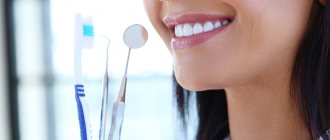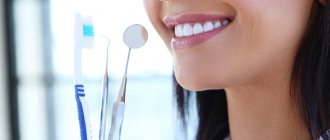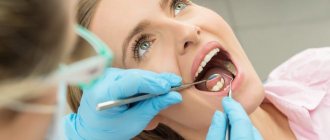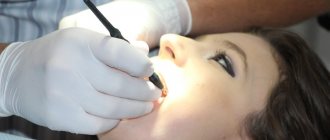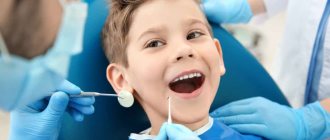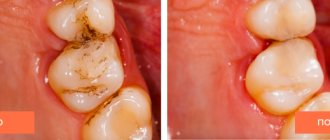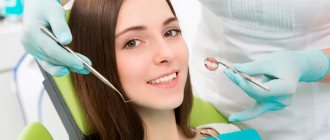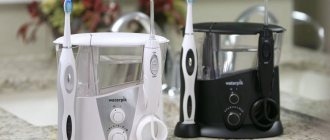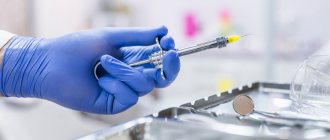You've probably come across the name of a dental service such as professional oral hygiene in an advertisement or on the Internet. And many people reasonably ask: why do you need to do oral hygiene at the dentist, if you can brush your teeth at home with a brush and toothpaste, use rinses and balms that are sold in the store?
The reason is quite simple: even regular and properly brushed teeth at home does not help to completely cleanse the oral cavity of soft plaque; it continues to accumulate and various pathogenic microorganisms actively multiply in it.
Their activities are fraught with the development of caries and inflammation of soft tissues. In addition, plaque can change the color of tooth enamel and teeth look unsightly.
professional oral hygiene procedure in dentistry helps to effectively remove plaque from dental surfaces and from all hard-to-reach places and thereby carry out effective prevention of almost all dental diseases
of dental oral hygiene include what methods are used to carry out the procedure? So that you can have answers to all these questions, we have prepared detailed material on the topic of professional dental and oral hygiene.
Dental and oral hygiene in dentistry: why is it so important to undergo the procedure regularly?
The main task of oral hygiene is to remove hard and soft plaque from the surfaces of the teeth, as well as other areas and areas of the mouth.
Regular and timely removal of dental plaque will be the best prevention of caries and other dental diseases. In addition, oral hygiene in dentistry contributes to:
- Formation of healthy strong teeth;
- Complete destruction of harmful microorganisms that live in large numbers in the human oral cavity;
- Prevention of periodontal and gastrointestinal diseases.
Professional dental and oral hygiene helps keep your teeth enamel in excellent condition - after brushing, your teeth become whiter and your smile looks attractive! Professional oral hygiene is especially recommended for people with bad habits: smokers, patients who abuse strong tea and coffee. The procedure is also indicated for people with poor immunity, because often malfunctions in the body’s immune system are expressed precisely in the appearance of caries and inflammation in the oral cavity.
Regular dental hygiene will ultimately result in significant savings on dental treatment costs.
Which is inevitable if the teeth are not properly cared for and are covered with a thick layer of plaque. So, professional oral hygiene is certainly not a waste of time and money; on the contrary, it is a valuable investment in your own health!
Indications and contraindications for professional oral hygiene in dentistry
Like any other medical procedure, dental and oral hygiene has its own indications and contraindications. Indications include:
- The presence of soft or hard plaque on the dental surfaces;
- Inflammatory process affecting the gums;
- Presence of tartar;
- Prevention of the development of caries and other dental diseases;
- Enamel pigmentation as a result of smoking, frequent consumption of tea and coffee.
USEFUL TO KNOW: The dental hygiene procedure also helps to brighten them. After all the activities, the teeth brighten by about one to two shades. This is already a good result, but if you need perfect whiteness, then it is better to use an additional service of modern dentistry after hygiene - professional whitening!
Professional dental and oral hygiene must be performed before prosthetics, implantation, orthodontic treatment using braces, installation of veneers and lumineers.
Also, the professional hygiene procedure can be part of complex therapy in the treatment of diseases such as periodontitis and periodontal disease. It is also recommended for expectant mothers to undergo professional cleaning of their teeth and oral cavity in dentistry: during pregnancy, the risks of caries increase significantly and high-quality oral hygiene will be an excellent prevention of this disease!
However, in some cases it is impossible to maintain oral and dental hygiene. For example, with stomatitis, general infectious diseases of the body in acute form. First, it will be necessary to eliminate these diseases and only then will it be possible to undergo the procedure.
Professional oral hygiene is not recommended in case of severe thinning of the enamel or erosion of the enamel coating of the teeth. Under such circumstances, the procedure can do more harm than good!
Indications and contraindications for professional dental and oral hygiene are determined at a dental appointment: the doctor will conduct an examination and tell you whether in your case it is possible to undergo the procedure immediately or whether preliminary measures will be needed that will improve the quality of hygiene and make it as safe as possible for you!
Professional oral hygiene
Professional oral hygiene is a set of measures carried out by a hygienist, which are aimed at the mechanical removal of dental plaque from the surface of the teeth and from under the gums. This includes professional teeth cleaning with ultrasound to remove tartar, plaque removal with an Air Flow device, polishing the tooth surface with special tools, as well as professional fluoridation of teeth.
Scheme of the action of ultrasound on tartar:
The principle of operation of the Air-Flow device on dental plaque:
Polishing teeth after removing tartar and plaque with a special fluoride-containing paste:
Gels for professional fluoridation using mouth guards for 3-5 minutes with fruit fillers:
A set of hygiene procedures is carried out for both children and adults. The frequency of teeth cleaning, whitening and other professional oral hygiene procedures is determined by the hygienist individually for each patient. Most people are recommended to have professional oral hygiene 1-2 times a year. Moreover, the professional hygiene course includes training in hygiene rules and the selection of individual products that are optimal for each patient. Agree, if your child learns to brush their teeth correctly from childhood, this will be the key to the health of his teeth and gums, his dazzling smile at any age, self-confidence, and, consequently, his success in life.
CLEAN TEETH DO NOT GET CARIES!
Many people develop brown plaque on their teeth from tea, coffee, and smoking. Salts from saliva settle on the resulting plaque, to which microbes from the oral cavity join. This is how tartar is formed. In tartar and plaque, pathological microorganisms multiply at tremendous speed, first causing inflammation of the gums, and then inflammation of the ligaments of the teeth and bone tissue around the teeth. Gingivitis develops first, the first sign of which is bleeding gums, and then periodontitis, in which the teeth begin to loosen. If immediate action is not taken, the development of periodontitis will lead to tooth loss.
Plaque and calculus before professional hygiene procedures:
After professional hygiene:
The development of gingivitis and periodontitis is influenced by the environment, living conditions, nutrition, and the general condition of the body. Moreover, the hereditary factor is important only in 2% of cases.
The frequency of deposition of tartar and plaque depends on the viscosity and composition of saliva, on the presence of bad habits (in particular, smoking), on the state of the bite (crowding of teeth), on the quality of the toothbrush, the frequency of personal hygiene, and the correct movements of the toothbrush while brushing the teeth ( not the time devoted to personal hygiene, as is popularly believed, but specifically the correct movements with the toothbrush). Naturally, the frequency of deposits of plaque and stones is also affected by diseases such as hypertension, urolithiasis, diabetes mellitus, liver diseases...
Dense, stained plaque and tartar cannot be completely removed by daily brushing. Therefore, it is necessary to regularly carry out hygiene procedures in the dental office.
For a clear demonstration to the patient and for a more thorough indication of the presence of plaque, the hygienist stains the teeth with a special liquid. In this case, clean teeth are not stained. “Fresh” plaque turns pink, and “old” plaque, which is more than a day old, turns purple. And the patient can see for himself those areas that need more thorough professional oral hygiene.
Caries and periodontal diseases develop only in conditions of insufficient oral hygiene. Prevention of caries and periodontal diseases is regular professional hygiene . Removing tartar is just as necessary as treating caries.
Oral hygiene in dentistry: what is included in the procedure?
In general, oral hygiene in dentistry is a complex event, which includes several procedures at once. Let's consider all these procedures in detail.
Inspection
The patient comes to the dentist, to the doctor’s office, and the specialist conducts a thorough examination of the oral cavity, determining the indications for professional hygiene and eliminating possible restrictions on its implementation. Also during the inspection, a cleaning method is selected. There are several technologies for removing plaque, and we will also tell you about them in a separate section of the article.
Cleaning
To remove hard and soft plaque during dental and oral hygiene, different techniques can be used. Each of them has its own characteristics, pros and cons, which are best familiarized with in advance.
Mechanical cleaning
This method is rarely used in modern dentistry for dental and oral hygiene.
It involves the use of hand-held, outdated instruments that can easily injure the sensitive soft tissues of the oral cavity. The only and very relative advantage of mechanical cleaning is the low price of the service. Photos before and after:
Ultrasound technique
This technology for removing plaque is considered the most modern and safe.
In it, the doctor will use a special installation and instrument - an ultrasonic scaler. This device is capable of creating ultrasonic waves of controlled frequency that destroy not only soft and pigmented plaque on dental surfaces, but also hard tartar. Photos before and after:
Ultrasound is capable of removing plaque not only on dental surfaces, but also in the most inaccessible areas, including periodontal pockets. Such ultrasonic cleaning capabilities are especially in demand when carrying out dental and oral hygiene in patients with periodontitis and periodontal disease.
Air-abrasive technique Air Flow
With this type of teeth and oral cavity cleaning, a special device is used that delivers a powerful water-air jet saturated with small abrasive particles to the dental surfaces.
Air, water and fine abrasive ideally remove soft and pigmented plaque and cleanse the area of periodontal pockets. The Air Flow technique is one of the most modern technologies for dental and oral hygiene; it is painless, does not injure tooth enamel, and has a minimum of contraindications.
Photos before and after:
USEFUL TO KNOW: Most often, Air Flow and ultrasonic cleaning are used in combination, because the first technology perfectly copes with soft and pigmented plaque, but is practically useless against old tartar.
Another cleaning technology used in modern dentistry is the laser technique. It uses a directed laser beam, which not only destroys plaque, but also destroys all pathogenic microflora in the oral cavity. The laser cleaning procedure is safe, it does not harm tooth enamel, and does not cause increased sensitivity of teeth and gums. In addition, laser cleaning promotes accelerated healing of various microcracks and wounds present in the oral cavity.
What cleaning method will be used in your case? You will decide this issue together with your doctor, because each method of cleaning dental surfaces during dental and oral hygiene has not only indications, but also contraindications.
But cleaning dental surfaces is far from the final stage of professional dental and oral hygiene procedures. After removing plaque, you will need to carry out the stages of polishing and grinding the surface of the teeth and remineralizing the tooth enamel.
Polishing
Polishing of dental surfaces is a mandatory step in dental and oral hygiene in dentistry.
High-quality polishing of teeth gives them a beautiful shine and perfect smoothness, thanks to which plaque does not accumulate on the enamel. The polishing stage is carried out during dental and oral hygiene with a specialized instrument.
Remineralization
Remineralization is a procedure that represents the final stage of dental and oral hygiene.
During this stage, the specialist treats the surfaces of the patient’s teeth with preparations containing fluoride and calcium. This treatment prevents the occurrence of unpleasant hypersensitivity of teeth, acts as an excellent prevention of caries, and in addition helps to strengthen and restore tooth enamel. Oral and dental hygiene ends with a detailed consultation with a doctor. The dentist explains in detail to the patient what dental care should be like after the procedure, and assists in choosing products and tools for everyday dental hygiene.
Is it painful to undergo oral and dental hygiene at the dentist?
Many people are afraid to visit the dentist and experience strong negative emotions even before undergoing such simple procedures as dental and oral hygiene. In this case, there is no need to be afraid: ultrasonic cleaning, polishing and remineralization - all these activities do not cause pain!
However, if you have increased tooth sensitivity, deep periodontal pockets will have to be cleaned - local anesthesia can be given, which completely removes all painful and unpleasant sensations during dental and oral hygiene.
And our dental clinic in Moscow - “Firadent” is ready to offer you two innovative services - dental and oral hygiene under sedation, that is, in a dream, as well as teeth cleaning under a microscope!
Examples of work “Before” and “After”
Combination of removable and fixed prosthetics
Case: Partial absence of chewing teeth in the upper and lower jaws, the need for prosthetics of the anterior teeth of the upper jaw.
Combined prosthetics and dental implantation (June 2012)
Case: a large number of teeth are destroyed, partial adentia, chewing function is impaired due to the absence of almost all chewing teeth Work: a detailed diagnosis of the condition of the teeth and bone tissue, studies of the tension of the masticatory muscles, the position of the articular head in the temporomandibular joint were carried out.
Classical implantation and dental prosthetics (October 2012)
Case: need for implantation of a primary canine.
Restoration of anterior teeth with zirconium dioxide crowns
Case: destruction of the crown part of the front teeth.
How to care for your teeth and oral cavity after a professional dental hygiene procedure?
Of course, you should also carry out dental and oral hygiene at home. Your doctor will tell you in detail how to do this correctly; he will also help you choose the right care products: paste, brush, and may recommend the use of additional tools - dental floss, brushes, irrigators.
General rules for dental and oral hygiene at home will be as follows:
1. Choose brushes of the correct degree of hardness for brushing your teeth and, best of all, with synthetic bristles;
2. To maintain high-quality oral hygiene, it will be useful to change the brush at least once every three months;
3. Teeth need to be brushed twice a day: in the morning and immediately before bed;
4. During oral hygiene procedures, it is imperative to brush not only your teeth, but also your gums and tongue. These measures will prevent the active accumulation of plaque and act as an excellent prophylaxis against periodontal diseases;
5. Don’t forget that you need to clean not only the surfaces of your teeth on both sides, but also the spaces between your teeth. To do this, it is recommended to use dental floss or special brushes.
Home oral and dental hygiene is not enough to completely remove plaque and tartar and monitor the appearance of caries, and therefore you need to visit the dentist 1-2 times a year and undergo a professional examination!
Sanitation of the oral cavity and its feasibility
Looking at the pages of glossy magazines, we never cease to admire the beauty and charm of famous people, actors, and top models. A smile plays an important role in the beauty and attractiveness of the face - large, snow-white, healthy teeth! We all admire them and want our teeth to be close to ideal too.
When a dentist sees such a smile, he immediately understands that a lot has been invested in it - money, the work of more than one doctor, but most importantly - the patience and understanding of the patient, because ideal, snow-white, straight teeth cannot be achieved in one day.
Let's consider two options for achieving the goal. The option is almost close to a dream - a person has naturally light-colored, beautifully shaped teeth and, it seems, he just has to learn how to show them off to others correctly.
The second option is not so favorable - the teeth are not straight, the color is disappointing, some had to be removed, and so on - you can safely forget about showing them to others. The owner of good and not very good teeth (options 1 and 2) faces completely different tasks! In the first case, preserve what nature has given, in the second, restore, improve, change what is available.
And oddly enough, in both cases patients will need: oral sanitation. Explaining what it is is the purpose of our article.
Oral sanitation is a set of measures aimed at improving the health of the oral cavity and preventing dental diseases. Sanitation of the oral cavity should be carried out throughout life, starting from childhood. Sanitation of the oral cavity includes the treatment of dental caries and the elimination of dental tissue defects by filling, the removal of decayed teeth and roots that cannot be treated, the removal of tartar and the treatment of periodontal diseases, orthodontic (correction of the bite position of the teeth) and orthopedic (restoration of the dentition) treatment.
This definition looks scary at first glance, but the most important thing here is to understand that the sooner you start paying due attention to your teeth, the shorter the list of measures to eliminate problems will be.
Patients who have experience in dental treatment at the ImplaDent dental clinic have already experienced the benefits of complex treatment from their own experience. The treatment regimen may look like this: when the patient first contacts the doctor, he examines the oral cavity and identifies problems that may exist: holes in the teeth, defects in fillings, the presence of plaque and tartar, the degree of inflammation of the gums, roots and decayed teeth. The doctor explains all this to the patient and draws up a treatment plan. If the mouth is neglected, treatment begins, as a rule, with the removal of decayed teeth and healing of the gums - this is done so that when restoring the preserved teeth, the conditions for aesthetic treatment are close to ideal. This helps the doctor choose the right color for fillings and metal-ceramic crowns and avoid defects in the marginal fit, which happens with bleeding, inflamed gums.
If the patient’s oral condition does not require such radical measures, the doctor explains to the patient the principles of oral hygiene, helps the patient choose the right toothbrush and toothpaste, and begins treatment of caries and dental restoration.
Next, it is important to understand that after undergoing a complete sanitation of the oral cavity, spending your patience, personal time and, of course, money, you must not forget about regular preventive examinations once a year or once every six months. Such examinations help to identify emerging problems in the early stages, because no doctor can guarantee you that in a tooth that has already been treated, caries will not appear again on another surface of the enamel, or that tartar will never form again if it has been removed once. I would like to summarize what has been said - every person who has once tidied up his mouth is familiar with the concept of oral sanitation , and believe me, if it was carried out correctly, he appreciated the actions of the doctors and the result obtained. The doctors of the ImplaDent dental clinic will always be able to explain to you the need for certain measures to improve the health of the oral cavity, draw up a treatment plan and professionally perform any procedure related to the treatment of teeth or gums, extraction or prosthetics.
Come, we can and want to help you!
Price for professional dental and oral hygiene in dentistry
To find out the exact price of professional dental and oral hygiene services, you will need to come to the clinic and undergo an examination by a dentist. This is important because the type of teeth cleaning will be determined based on your individual characteristics. Perhaps you have contraindications for some type of cleaning, or in your case a certain technology will work optimally.
If you want to find out the maximum useful details not only about the cost of a professional oral hygiene procedure, but also about the stages of its implementation, the doctors of our dentistry in Moscow “Firadent” will be happy to help you!
You can get a detailed free consultation from our specialists at any time convenient for you: just contact us by phone number and make an appointment!
"Firadent" - we will help make your teeth healthy and your smile bright and attractive!
